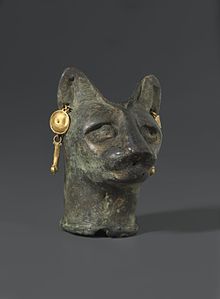Description
Cats (Felis silvestris catus), known in ancient Egypt as “Mau“, were considered sacred in ancient Egyptian society. Based on recent DNA comparisons of living species, it has been estimated that cats were first domesticated from the Middle Eastern subspecies of the wildcat about 10,000 years ago in the Fertile Crescent. Thousands of years later, the peoples in what would later be Upper and Lower Egypt had a religioncentred on the worship of animals, including cats.
Praised for controlling vermin and its ability to kill snakes such as cobras, the domesticated cat became a symbol of grace and poise.
As domestication was not as steadfast with cats as today, wealthy families would often curate examples of well bred felines, show them, and pride themselves in the coloration and behavioural adaptations that are seen in today’s organized shows.
The goddess Mafdet, the deification of justice and execution, was a lion-headed goddess. The cat goddess Bast (also known as Bastet) eventually replaced Mafdet, and Bast’s image softened over time and she became the deity representing protection, fertility, and motherhood.
As a revered animal and one important to Egyptian society and religion, some cats received the same mummification after death as humans. Mummified cats were given in offering to Bast. In 1888, an Egyptian farmer uncovered a large tomb with mummified cats and kittens. This discovery outside the town of Beni Hasan had eighty thousand cat mummies, dated after 1000 BC. The punishments for harming cats were severe.

Cat’s Head, 30 BC to third century AD Bronze, gold. Brooklyn Museum

Cat with Kittens, c. 664-30 BC or later. Bronze, wood. The Egyptians associated the female cat’s fertility and motherly care with several divinities. The base of the statuette of Cat with Kittens is inscribed with a request that Bastet grant life, directly linking the cat pictured here with the goddess Bastet. Brooklyn Museum
Cats were one of the most recognizable species in Egyptian culture and were domesticated much later than dogs.[citation needed] Two types of smaller cats appeared in ancient Egypt: the jungle cat (Felis chaus) and the African wild cat (Felis silvestris libyca). The African wild cat was domesticated from the Predynastic Period onward.[4] Wild cats naturally preyed upon the rats and other vermin that ate from the royal granaries. They earned their place in towns and cities by killing mice, venomous snakes, and other pests. They were worshipped by the Egyptians and given jewelry in hieroglyphics.[citation needed]
Small cats would often be found underneath women’s chairs on reliefs, evoking fertility and sexuality. The other variety of cat, the lion, was also prevalent in Egyptian culture.[citation needed] Although most lions receded to the south around the Predynastic Period, lions were rare in pharaonic times, but were extremely important in Egyptian iconography. Lions represented royal authority because of their aggressive nature and power

